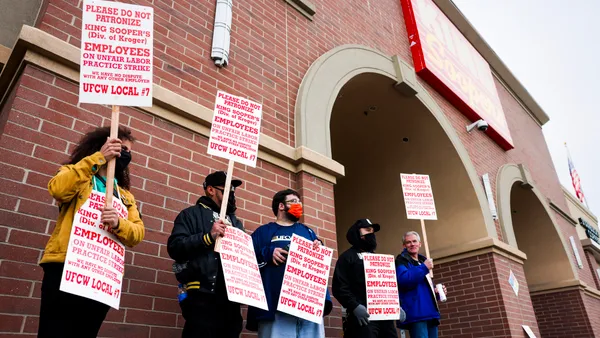Dive Brief:
- Grocery delivery orders through Amazon Fresh and Whole Foods Market more than doubled in the fourth financial quarter of 2019 compared to the same period a year ago, the company announced Thursday. Delivery through the two services, which both now operate under Amazon Prime, is currently available in more than 2,000 cities.
- Robust holiday sales and the strength of Amazon Web Services pushed the company past Wall Street estimates, with net income up 8% to $3.3 billion and net sales up 21% to $87.4 billion. Amazon now counts more than 150 million Prime members globally. Physical store sales, the majority of which comes from Whole Foods stores, declined 1% to $4.36 billion during Q4.
- “We believe customers are starting to notice and take advantage of [grocery delivery],” Brian Olsavsky, Amazon's chief financial officer, said during Thursday’s earnings call. “We will see where peoples’ tastes and preferences will take them, whether they go to Whole Foods stores, use Prime Now or Amazon delivery for their groceries. Right now, we’re really just testing and reacting to customer demands and preferences, and we’ll do so for the foreseeable future.”
Dive Insight:
More than two years and hundreds of Prime deals later, Amazon still isn’t showing signs it’ll reawaken sales growth at Whole Foods stores. But that won’t matter much to Amazon as long as its online grocery business is accelerating.
The number of cities where Whole Foods offers home delivery increased by roughly one third over last year’s Q4, while Amazon Fresh came online in several cities last year, including Las Vegas and Houston, following a dormant period beginning in late 2017.
Expansion didn’t account for all of Amazon’s e-grocery growth in the quarter. Although Amazon on Thursday didn’t directly link improving delivery sales to its decision to fold Amazon Fresh into its Prime program and do away with the $15 monthly fee, recent reports show the move has significantly boosted customer adoption.
Consulting firm Brick Meets Click said in a report that suppliers it has spoken with reported increased sales following the integration, while a note last week from financial company Morningstar said it saw “widespread interest” in Fresh after the October decision. Morningstar counts it as the most significant move in online grocery in 2019.
“Our analysis suggests not only a meaningful uptick in consumer awareness of Amazon’s grocery delivery capabilities, but also a 30%-plus increase in consumer adoption and order frequency rates based on website traffic and physical activity at Amazon Fresh fulfillment centers,” Morningstar analyst R.J. Hottovy wrote.
Consumers consistently cite high costs as a barrier to online grocery adoption. And with Amazon Fresh’s expanding availability and deep well of Prime members to market to, the service has become easier to adopt in markets where it’s available.
This comes as retailers like Walmart, SpartanNash and Albertsons have also lowered prices and rolled out e-commerce subscriptions. But competing with Prime and its large suite of perks will prove challenging.
Leveraging Prime across its grocery delivery properties will help Amazon better track consumers and develop products and services that appeal to them, according to Brick Meets Click.
“The richer data set that Amazon is able to develop as a result of leveraging Prime to accelerate its appeal among high-value, affluent households is powerful," the firm wrote in a report emailed to Grocery Dive. "It will enable Amazon to do in grocery what it’s done in other parts of its business — identify offers and services that provide greater value for each household.”
It will also help Amazon determine prime locations for its forthcoming grocery chain as well as Whole Foods stores, Brick Meets Click noted. So while Amazon hasn’t yet dazzled the grocery industry, that could all change very soon.













